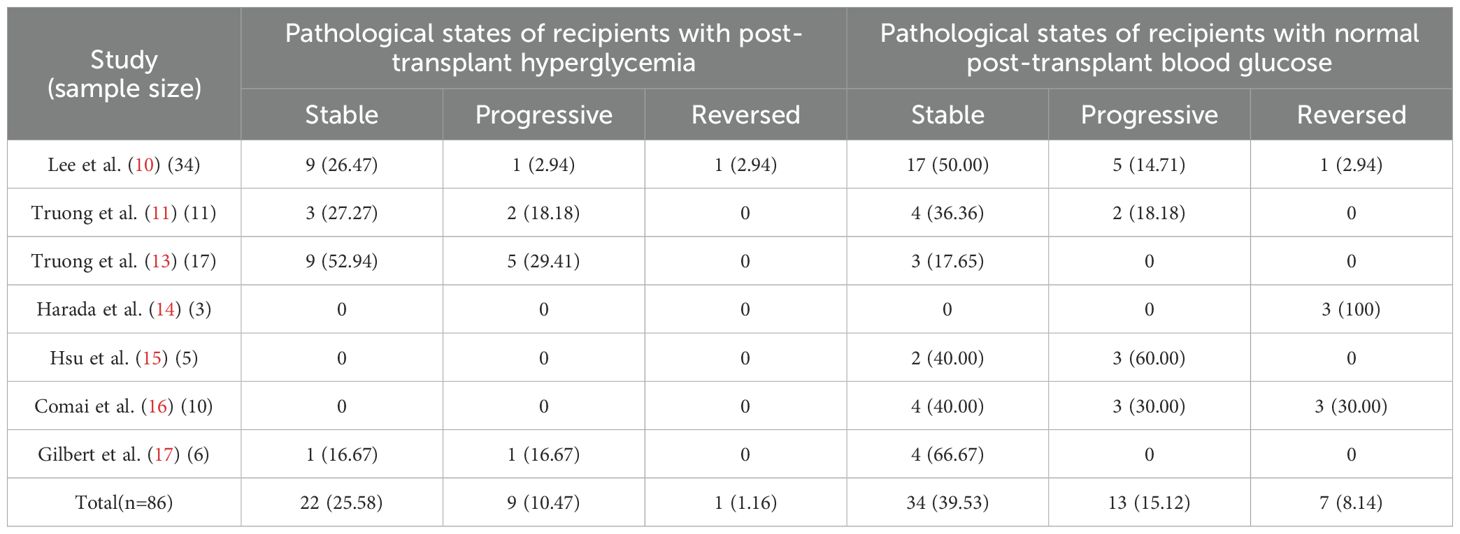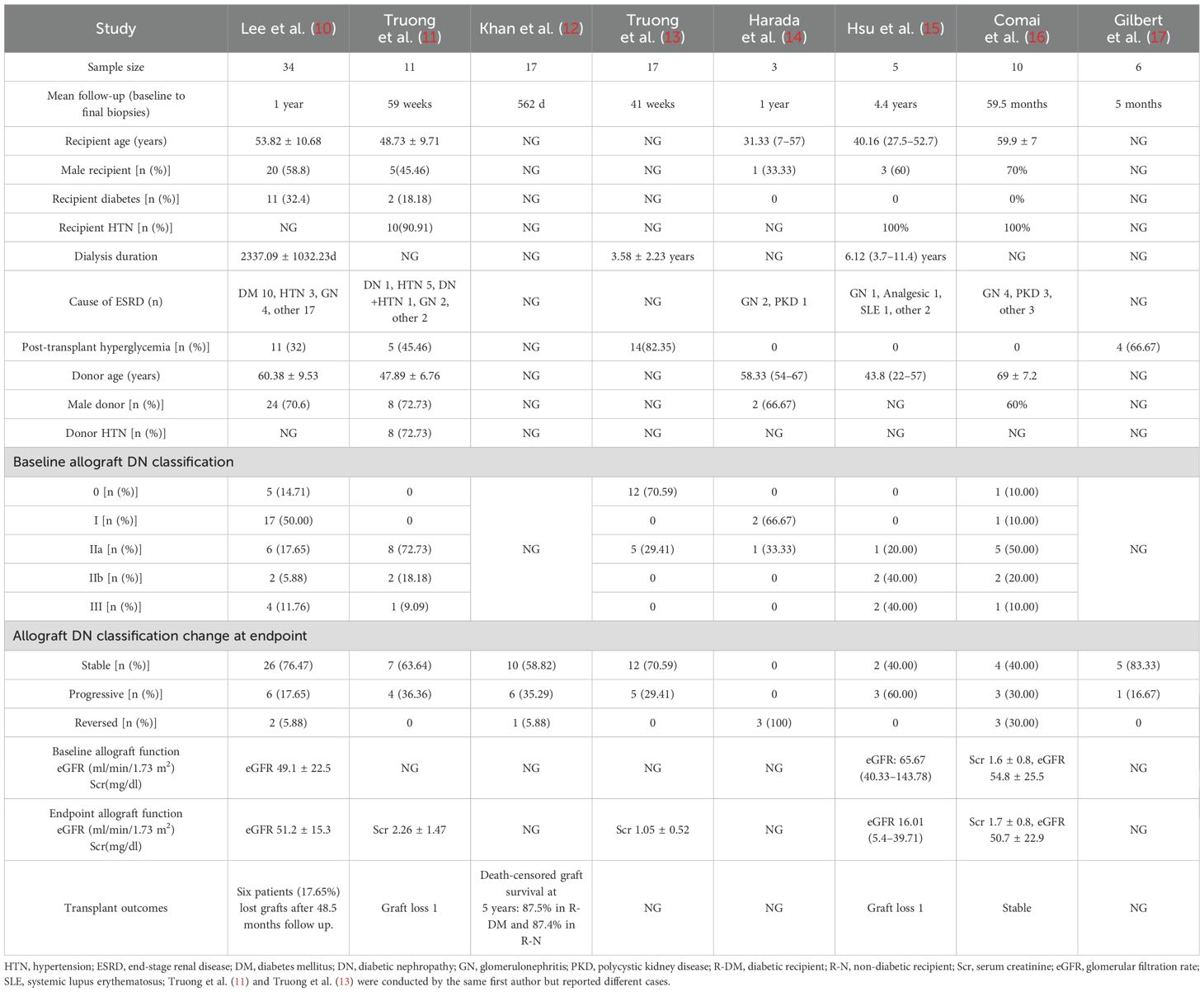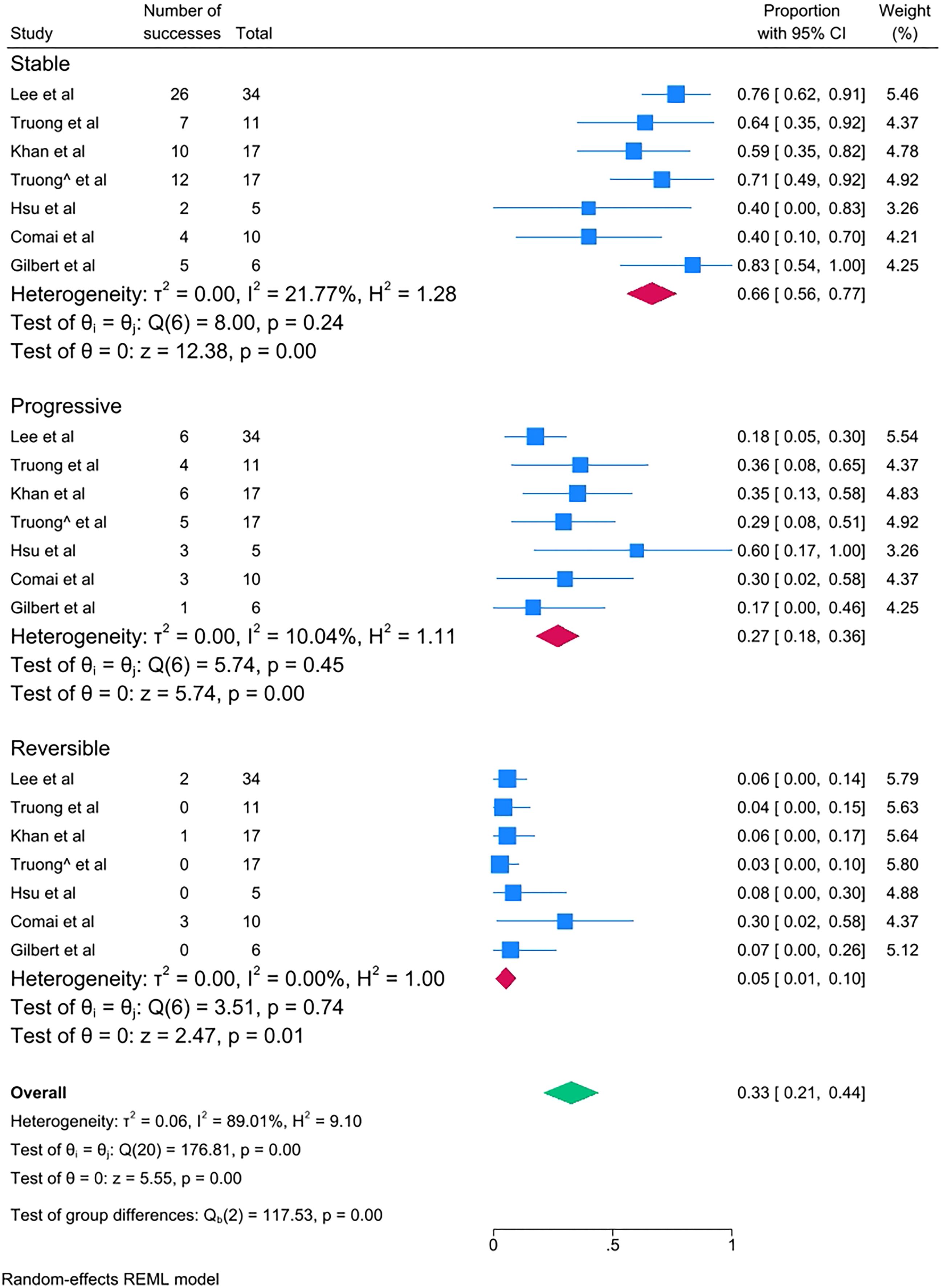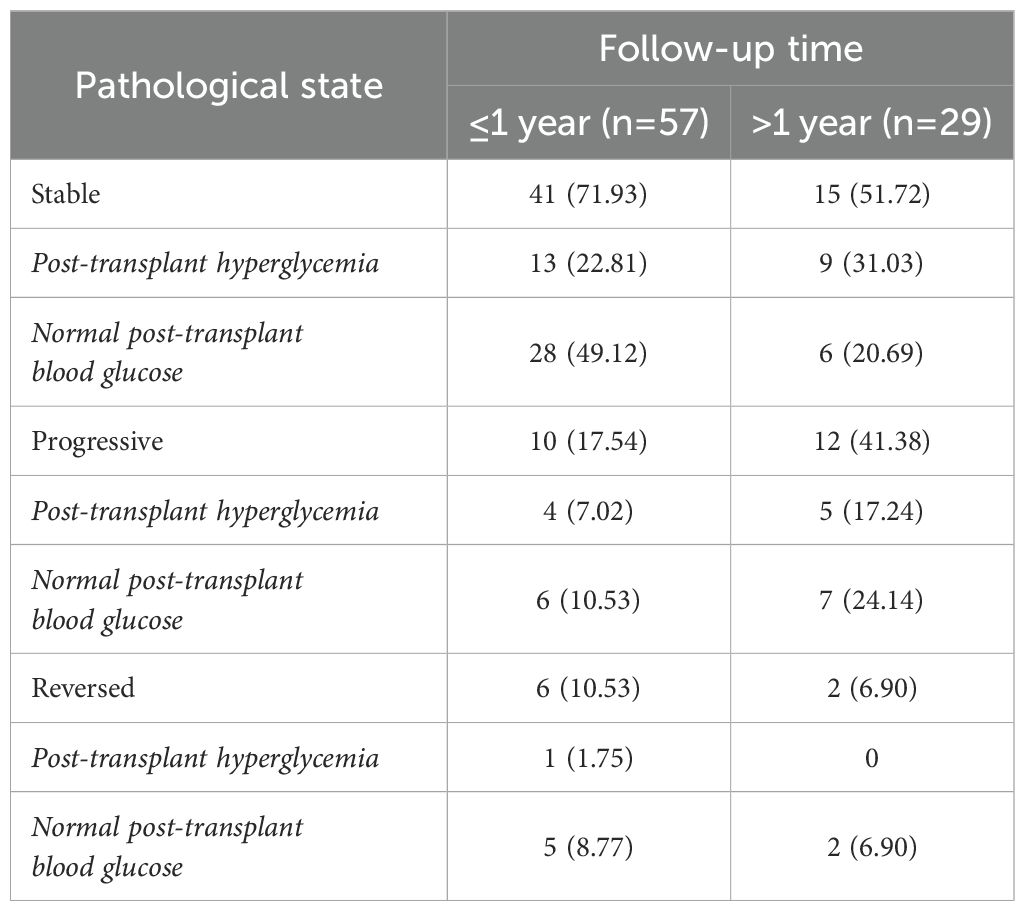- 1Department of Urinary Nephropathy Center, The Second Affiliated Hospital of Chongqing Medical University, Chongqing, China
- 2Department of Clinical Laboratory, The First Naval Hospital of Southern Theater Command, Zhanjiang, China
Introduction: Kidney transplantation from expanded-criteria donors represents an effective approach to alleviate organ shortages. The feasibility for transplantation of donor kidneys with preformed diabetic nephropathy (DN) has not been extensively investigated.
Search strategy: We performed a literature review to explore the pathological changes and clinical outcomes of kidney transplantation using preformed DN kidney. A systematic and comprehensive search was conducted from the inception to June 13, 2024.
Results: Data from eight articles encompassing 103 cases were included for analysis. The pooled proportions of stable, progressive, and reversed DN-related pathological change were 0.66 (95% CI 0.56–0.77, I2 = 21.77%), 0.27 (95% CI 0.18–0.36, I2 = 10.04%) and 0.05 (95% CI 0.01–0.10, I2 = 0.00%), respectively. Eight-six cases were divided into post-transplant hyperglycemia group and normal post-transplant blood glucose group to evaluate the effect of post-transplant hyperglycemia on DN pathology, indicating the normal post-transplant blood glucose group had higher proportions of stable and reversed pathological states. Most cases achieved a graft survival rate of more than 80% at around five years post-transplant.
Conclusion: A majority of transplantations use donor kidneys with preformed DN exhibit acceptable renal pathological changes and graft survival. However, post-transplant hyperglycemia may adversely affect the pathological progression of the kidneys, particularly in cases with long-term follow-up.
1 Introduction
Kidney transplantation, an optimal treatment for end-stage renal disease, is impeded by organ scarcity. A highly frustrating yet effective strategy is to enlarge the donor pool by expanding the donor criteria and fully exploiting all accessible grafts. Prior to kidney transplantation, multiple reporting systems such as the Remuzzi score, Banff criteria, and the kidney donor profile index are employed to evaluate the quality of donor kidneys; pathological features (including the rate of glomerulosclerosis, tubular atrophy, and interstitial fibrosis) assume a crucial role (1, 2).
China has one of the highest incidence rates of diabetes mellitus (DM) worldwide, and diabetic nephropathy (DN) has emerged as the primary cause of end-stage renal disease (3, 4). A considerable proportion of organ donation volunteers are patients with DM or DN, and between 2008 and 2019, half of the kidneys from donors with diabetes were rejected because of pathological lesions (5). Nevertheless, some recent large-scale retrospective studies have indicated that kidney transplants from donors with DM can effectively reduce the waiting time for recipients, and no significant differences in the glomerular filtration rate (eGFR) or urinary protein excretion have been observed compared with transplants from donors without DM (6).
Hyperglycemia induced by DM results in mesangial cell proliferation, podocyte damage, and endothelial cell decompensation, ultimately giving rise to DN (7). Glomerular lesions in DN can be categorized into four types. The diagnosis of class IV requires a ratio of over 50% of glomerular sclerosis and such tissues are evidently not suitable for transplantation. In the classification of glomerular lesions, the proportion of glomerular sclerosis below stage III has not been stated (8). Research by Mohan indicated that the DN kidney can be utilized for transplantation when the number of sclerotic glomeruli is controlled within a certain range (9). It thus appears that lesions related to DN have not been included in the criteria for rejection. Few studies have reported the feasibility of DN kidneys for transplantation, an issue that requires further exploration. Based on this predicament, a systematic review of the literature was carried out to explore the current status of clinical practice of preformed DN in kidney transplantation.
2 Methods
2.1 Search strategy and study selection
We performed a systematic and comprehensive search of the PubMed database, using kidney transplant recipient, kidney transplantation, renal transplantation, diabetic donor, diabetic nephropathy, diabetic kidney disease, diabetes mellitus, hemoglobin A1c, hyperglycemia, histology, pathology, and biopsy as keywords, with a deadline by June 13, 2024. The references of the selected articles were manually searched to obtain other relevant entries. The search strategy was presented in Additional file 1. Inclusion criteria: 1) The literatures related to kidney transplantation with DN kidney were selected; 2) Both baseline and follow-up biopsy information was described in detail; 3) Clinical outcomes of transplantation were reported. Exclusion criteria: 1) Non-English articles, conference articles, and reviews, case reports (<3 cases) were excluded; 2) Articles without baseline or follow-up pathological data on kidney biopsies were excluded. The flow chart of study selection was presented in Supplementary Figure 1. Baseline biopsy referred to time-zero graft kidney biopsy or first biopsy within 2 weeks post-transplantation. The relevant articles were included to assess the pathological changes related to DN, the effect of post-transplant hyperglycemia on pathological progression, and the progression of graft function.
2.2 Quality assessment
The methodological quality of included studies was evaluated using the Joanna Briggs Institute (JBI) Critical Appraisal Tools for case reports and case series. The assessment focused on eight criteria for case reports and ten criteria for case series, including clarity of patient demographics, comprehensiveness of case descriptions, diagnostic assessments, interventions, and outcome reporting. Each criterion was scored as “yes,” “no,” “unclear,” or “not applicable.” Studies were rated as “good” if they met ≥ 75% of the criteria, “fair” if they met 50–74%, and “poor” if they met < 50%. Detailed quality assessments for each study are presented in Supplementary Table 1.
2.3 Statistical analysis
The meta package of Stata/MP 18.0 was used. A proportion of the meta-analysis used the inverse variance method and a random effects model to estimate the magnitude of the effects. Heterogeneity was quantified with I2 and τ2 statistics. The outcomes of interest were treated as dichotomous variables, with their respective 95% confidence intervals (95% CI).
3 Results
3.1 Study characteristics
We analyzed data from eight studies (10–17) with a total of 103 recipients (Table 1). The mean follow-up time of patient biopsies ranged from 5 to 59.5 months. Blood glucose status after kidney transplantation was reported in 86 cases, of which 54 described normal blood glucose levels and 32 hyperglycemia. The demographic data of the included patients from the studies by Khan et al. (12), Truong et al., and Gilbert et al. (17) referred to the cohorts to which they belonged. Khan et al. and Gilbert et al. did not report the detailed baseline DN pathological classification, while pathological changes between baseline and endpoint biopsies were described.
3.2 Pathological changes of preformed DN transplantation
The pathological changes of preformed DN transplantation were described in Table 1. Among the 103 recipients, proportions of stable, progressive and reversed states were 64.08% (66/103), 27.18% (28/103) and 8.74% (9/103). Proportional meta-analyses were conducted to assess the pooled proportion of stable, progressive, and reversed DN pathological changes among the examined cases. Of the 103 cases that were included in the primary meta-analysis, a high degree of heterogeneity was found in the stable (I2 = 64.13%) and reversible (I2 = 91.43%) subgroups. After excluding the study by Harada et al. (14) that reported only three cases, the degree of heterogeneity was controlled. As shown in Figure 1, the pooled proportion of stable DN-related pathological change was 0.66 (95% CI 0.56–0.77, I2 = 21.77%); the pooled proportion of progressive DN-related pathological change was 0.27 (95% CI 0.18–0.36, I2 = 10.04%); and the pooled proportion of reversed DN-related pathological change was 0.05 (95% CI 0.01–0.10, I2 = 0.00%). The above subgroup meta-analysis indicated that the degree of heterogeneity was low (I2<25%); therefore, no further heterogeneity analyses were performed.
3.3 Progression of graft function
Three studies—by Lee et al. (10), Hsu et al. (15), and Comai et al. (16)—reported that the baseline mean eGFR of graft kidney ranged from 49.1 ml/min/1.73 m2 to 65.67 ml/min/1.73 m2 after kidney transplantation, indicating relatively good primary graft function. At the endpoint (final biopsy), three studies—by Lee et al. (10), Truong et al. (13), and Comai et al. (16)—with 61 cases showed stable graft function. In contrast, two small sample-size studies—by Truong et al. (11) and Hsu et al. (15)—showed worsening graft function due to two cases of graft loss. Four studies—by Lee et al. (10), Khan et al. (12), Hsu et al. (15), and Comai et al. (16)—with mean follow-up times ranging from 48.5 months to 5 years reported long-term graft survival rates of 82.3%, 87.4–87.5%, 80%, and 100%, respectively.
3.4 Post-transplant hyperglycemia and pathological state of recipients
As mentioned above, post-transplant blood glucose levels were reported for 86 recipients. Among the recipients with hyperglycemia, stable pathological changes were observed in 22(25.58%), progression in 9(10.47%), and reversal in one (1.16%). In the non-hyperglycemic recipient group, DN-related changes were stable in 34(39.53%) recipients but progressed in 13(15.12%) and were reversed in seven (8.14%). Compared to hyperglycemic recipient group, the non-hyperglycemic recipient group had higher proportions of stable state (39.53% versus 25.58%) and reversed state (8.14% versus 1.16%) (Table 2). Of the 8 reversed cases, the pathological reversal time was about one-year post-transplant in four cases, about two years post-transplant in two cases and about five years post-transplant in two cases. To investigate the effect of the duration of post-transplant hyperglycemia on DN pathology, the 86 recipients were divided into two groups based on whether the follow-up time exceeded one year. Accordingly, 57 recipients were followed up for less than one year and 29 for more than one year. In the former group, pathological changes remained stable in 41 patients (71.93%), progressed in 10(17.54%), and were reversed in six (10.53%). Among the recipients with a follow-up time of more than one year, a stable state was reported for 15(51.72%), progression for 12(41.38%), and reversal in two (6.90%), indicating a higher proportion of progression state (41.38% versus 17.54%) when compared to recipients with a follow-up time less than one year (Table 3).

Table 2. Distribution of pathological states in post-transplant hyperglycemia and normal post-transplant blood glucose recipients.
4 Discussion
The main objective for preparing this comprehensive review was to conduct an in-depth investigation to determine whether organs with preformed DN could be deemed effective for transplantation. In 1983, a remarkable study reported that a recipient without diabetes received a kidney from a donor with confirmed DN, and a detailed graft biopsy procedure revealed a surprising reversal of DN lesions at seven months post-transplant (18, 19). These constitute the earliest reports to suggest that preformed DN can indeed be selected for transplantation and that the alterations associated with preformed DN have the potential to be reversed in conjunction with changes in the recipient’s glucose levels.
Among the included preformed DN kidney transplantations, a stable state in terms of pathological changes was noted in the majority of the recipients, progression state accounted for a lower proportion, while reversed state accounted for 8.74%. In this review, we analyzed two influence factors of DN progression including post-transplant hyperglycemia and follow-up time. With regard to the effect of post-transplant hyperglycemia, recipients without hyperglycemia had higher proportions of stable and reversed pathological change, suggesting that the post-transplant hyperglycemic state is critical for the progression of preformed DN renal pathology. Meanwhile, we found included recipients whose follow-up time less than one year had higher proportions of stable and reversed state, and had a lower proportion of progressive state. However, the proportion of progressive state increased notably in the context of follow-up time exceed one year. As we know, DN progression is influenced by a combination of multiple factors over time. Generally, early ischemia–reperfusion injury, potential acute and chronic rejection, viral infection, and extensive use of immunosuppressive drugs can have a significant impact on the pathological progression of preformed DN after renal transplantation. It is important to note that these factors interact and compound one another’s effects, creating a complex web of influences that can further complicate prognosis (20–22).
Among included recipients, a few instances were recorded in which the pathological changes were reversed after transplantation, and pathological reversal was more common in patients without hyperglycemia than in those with hyperglycemia after transplantation. Wu et al. found that early-stage DN is reversible, which is related to reduced NOX expression and improvement in mitochondrial function after transplantation (23). Previous studies on islet or pancreatic transplantation imply that pathological tissues such as in DN undergo remodeling after normal blood glucose levels are achieved, but remodeling demands a longer time, approximately 5 years (24–26). Through a comprehensive literature review of the transplantations using donor with preformed DN, we identified four cases of DN pathological reversal under the circumstances of non-hyperglycemia after a long-term follow-up, two were reversed at five-year post-transplant (16), one was reversed at seven-year post-transplant (27), and one was at nine-year post-transplant (28), respectively. The above studies reflected that donor DN pathology can be reversed at early or late post-transplant period, and normal post-transplant blood glucose is crucial for pathological reversal.
Regarding the mean baseline eGFR post-transplant, our conclusion based on the data in the included long-term follow-up studies was that the range 49.1–65.67 ml/min/1.73 m2 is comparable with the data presented in the 2022 OPTN/SRTR report (45 ml/min/1.73 m2) (29). Four studies reported long-term graft survival rates of 82.3%, 87.4–87.5%, 80%, and 100%, which are comparable with the data presented in the 2022 OPTN/SRTR report—a five-year graft survival rate of 81.4% in deceased donor kidney transplant recipients aged 18–34 years (29). These studies indicated the preformed DN transplantation can achieve comparable graft survival to that of conventional kidney transplantation.
In conclusion, kidney transplantation from donors with preformed DN presented stable pathological changes in most cases and was accompanied with acceptable graft survival. Normal post-transplant blood glucose was beneficial to DN pathological stability and pathological reversal. Unfortunately, the restricted number of cases and limited follow-up time negatively affects the validity of our conclusions, and more high-quality cohort studies are urgently needed to explore this important clinical question.
Author contributions
SL: Conceptualization, Data curation, Writing – review & editing, Writing – original draft, Investigation. YW: Writing – review & editing, Formal analysis. BC: Validation, Writing – review & editing. MT: Formal analysis, Writing – review & editing, Validation. KZ: Writing – original draft, Project administration, Conceptualization. LS: Writing – review & editing, Software.
Funding
The author(s) declare that no financial support was received for the research and/or publication of this article.
Conflict of interest
The authors declare that the research was conducted in the absence of any commercial or financial relationships that could be construed as a potential conflict interest.
Generative AI statement
The author(s) declare that no Generative AI was used in the creation of this manuscript.
Publisher’s note
All claims expressed in this article are solely those of the authors and do not necessarily represent those of their affiliated organizations, or those of the publisher, the editors and the reviewers. Any product that may be evaluated in this article, or claim that may be made by its manufacturer, is not guaranteed or endorsed by the publisher.
Supplementary material
The Supplementary Material for this article can be found online at: https://www.frontiersin.org/articles/10.3389/fendo.2025.1599660/full#supplementary-material
Abbreviations
CI, confidence intervals; DM, diabetes mellitus; DN, diabetic nephropathy; eGFR, estimated glomerular filtration rate; HTN, hypertension; ESRD, end-stage renal disease; GN, glomerulonephritis; PKD, polycystic kidney disease; R-DM, diabetic recipient; R-N, non-diabetic recipient; Scr, serum creatinine; SLE, systemic lupus erythematosus.
References
1. Gomes Filho FF, Modelli de Andrade LG, Amaro JL, Barreti P, Yamamoto HA, Guerra R, et al. Impact of time-zero biopsy on the outcome of transplanted kidneys. Transplant Proc. (2021) 53:2895–9. doi: 10.1016/j.transproceed.2021.09.016
2. Gandolfini I, Buzio C, Zanelli P, Palmisano A, Cremaschi E, Vaglio A, et al. The kidney donor profile index (KDPI) of marginal donors allocated by standardized pretransplant donor biopsy assessment: distribution and association with graft outcomes. Am J Transplant. (2014) 14:2515–25. doi: 10.1111/ajt.12928
3. Weng J and Bi Y. Epidemiological status of chronic diabetic complications in China. Chin Med J. (2015) 128:3267–9. doi: 10.4103/0366-6999.171350
4. Zhang X, Kong J, and Yun K. Prevalence of diabetic nephropathy among patients with type 2 diabetes mellitus in China: A meta-analysis of observational studies. J Diabetes Res. (2020) 3:2315607. doi: 10.1155/2020/2315607
5. Hart A, Lentine KL, Smith JM, Miller JM, Skeans MA, Prentice M, et al. OPTN/SRTR 2019 annual data report: kidney. Am J Transplant. (2021) 21:21–137. doi: 10.1111/ajt.16502
6. Cohen JB, Eddinger KC, Locke JE, Forde KA, Reese PP, and Sawinski DL. Survival benefit of transplantation with a deceased diabetic donor kidney compared with remaining on the waitlist. Clin J Am Soc Nephrol. (2017) 12:974–82. doi: 10.2215/CJN.10280916
7. Hoshino J, Mise K, Ueno T, Imafuku A, Kawada M, Sumida K, et al. A pathological scoring system to predict renal outcome in diabetic nephropathy. Am J Nephrol. (2015) 41:337–44. doi: 10.1159/000431333
8. Tervaert TW, Mooyaart AL, and Amann K. Pathologic classification of diabetic nephropathy. J Am Soc Nephrol. (2010) 21:556–63. doi: 10.1681/ASN.2010010010
9. Mohan S, Tanriover B, Ali N, Crew RJ, Dube GK, Radhakrishnan J, et al. Availability, utilization and outcomes of deceased diabetic donor kidneys; analysis based on the UNOS registry. Am J Transplant. (2012) 12:2098–105. doi: 10.1111/j.1600-6143.2012.04167.x
10. Lee KW, Sim J, Park SSW, Jeon J, Kim G, Kim MJ, et al. Recoverability of diabetic nephropathy of donor kidney after kidney transplantation. Transplant Int. (2022) 35:10714. doi: 10.3389/ti.2022.10714
11. Truong LD, Gaber LW, and Khan F. Donor-related diabetic nephropathy: a comprehensive clinicopathological study. Hum Pathol. (2019) 85:136–44. doi: 10.1016/j.humpath.2018.10.032
12. Khan FN, Truong LD, Nguyen DT, Graviss EA, Bhatti MI, Frost AE, et al. Outcomes of kidney transplantation using deceased donors with history of diabetes. Clin Transplant. (2020) 34:e13775. doi: 10.1111/ctr.13775
13. Truong LD, Suki WN, Gaber LW, Gaber OA, and Khan F. Kidney donors with diabetes: renal biopsy findings at time of transplantation and their significance. Transplant Direct. (2019) 5:e465. doi: 10.1097/TXD.0000000000000903
14. Harada S, Ushigome H, Nishimura A, Nakao T, Nakamura T, Koshino K, et al. Histological reversibility of diabetic nephropathy after kidney transplantation from diabetic donor to non-diabetic recipient. Nephrology. (2015) 20:40–4. doi: 10.1111/nep.12451
15. Hsu C, Wen MC, Chiu HF, Tsai SF, Yu TM, Yang CK, et al. Ongoing donor-transmitted diabetic kidney disease in kidney transplant recipients with fair sugar control: a single center retrospective study. BMC Nephrol. (2020) 21:458. doi: 10.1186/s12882-020-02132-w
16. Comai G, Corradetti V, Bini C, Tondolo F, Hu L, Valente S, et al. Histological findings of diabetic kidneys transplanted in non-diabetic recipients: a case series. Int Urol Nephrol. (2023) 55:2611–9. doi: 10.1007/s11255-023-03552-x
17. Gilbert A, Scott D, Stack M, Mattos AD, Norman D, Rehman S, et al. Long-standing donor diabetes and pathologic findings are associated with shorter allograft survival in recipients of kidney transplants from diabetic donors. Modern Pathol. (2022) 35:128–34. doi: 10.1038/s41379-021-00927-2
18. Abouna GM, Al-Adnani MS, Kremer GD, Kumar SA, Daddah SK, and Kusma G. Reversal of diabetic nephropathy in human cadaveric kidneys after transplantation into non-diabetic recipients. Lancet. (1983) 2:1274–6. doi: 10.1016/S0140-6736(83)91151-0
19. Abouna GM, Adnani MS, Kumar MS, and Samhan SA. Fate of transplanted kidneys with diabetic nephropathy. Lancet. (1986) 1:622–3. doi: 10.1016/S0140-6736(86)92849-7
20. Parekh J, Niemann CU, Dang K, and Hirose R. Intraoperative hyperglycemia augments ischemia reperfusion injury in renal transplantation: a prospective study. J Transplant. (2011) 2011:652458. doi: 10.1155/2011/652458
21. Rudzki G, Knop-Chodyła K, Piasecka Z, Kochanowska-Mazurek A, Głaz A, Wesołek-Bielaska E, et al. Managing post-transplant diabetes mellitus after kidney transplantation: challenges and advances in treatment. Pharm (Basel). (2024) 17:987. doi: 10.3390/ph17080987
22. Langsford D and Dwyer K. Dysglycemia after renal transplantation: Definition, pathogenesis, outcomes and implications for management. World J Diabetes. (2015) 6:1132–51. doi: 10.4239/wjd.v6.i10.1132
23. Wu W, Jin Y, Teng L, Shao X, Wang Y, Feng S, et al. Mitochondria-related reversal of early-stage diabetic nephropathy in donor kidney after transplantation in mice. Ann Transl Med. (2019) 7:801. doi: 10.21037/atm.2019.12.55
24. Mauer SM, Sutherland DE, Steffes MW, Leonard RJ, Najarian JS, Michael AF, et al. Pancreatic islet transplantation. Effects on the glomerular lesions of experimental diabetes in the rat. Diabetes. (1978) 22:748–53. doi: 10.2337/diab.23.9.748
25. Shapiro AMJ, Pokrywczynska M, and Ricordi C. Clinical pancreatic islet transplantation. Nature reviews. Endocrinology. (2017) 13:268–77. doi: 10.1038/nrendo
26. Fioretto P and Mauer M. Reversal of diabetic nephropathy: lessons from pancreas transplantation. J Nephrol. (2012) 25:13–8. doi: 10.5301/jn.5000061
27. Tanaka R, Imamura R, Matsumura S, Fukae S, Taniguchi A, Nakazawa S, et al. Remarkable improvement of diabetic nephropathy in transplanted allograft after kidney transplantation. Nephron. (2024) 148:468–73. doi: 10.1159/000535877
28. Li X, Wang W, Jiang J, Cheng D, and Chen J. Histopathologic remission of severe diabetic nephropathy of donor kidney after kidney transplantation: A case report. Transplant Proc. (2024) 56:2055–7. doi: 10.1016/j.transproceed.2024.10.002
Keywords: diabetic nephropathy, preformed diabetic nephropathy, donor, transplantation, post-transplant hyperglycemia
Citation: Li S, Wang Y, Chen B, Tang M, Zhang K and Shen L (2025) Kidney transplantation with preformed diabetic nephropathy kidney: review of pathological changes and clinical outcomes. Front. Endocrinol. 16:1599660. doi: 10.3389/fendo.2025.1599660
Received: 25 March 2025; Accepted: 11 June 2025;
Published: 01 July 2025.
Edited by:
Pedro Henrique Franca Gois, The University of Queensland, AustraliaReviewed by:
Antonio J. Amor, Hospital Clinic of Barcelona, SpainCopyright © 2025 Li, Wang, Chen, Tang, Zhang and Shen. This is an open-access article distributed under the terms of the Creative Commons Attribution License (CC BY). The use, distribution or reproduction in other forums is permitted, provided the original author(s) and the copyright owner(s) are credited and that the original publication in this journal is cited, in accordance with accepted academic practice. No use, distribution or reproduction is permitted which does not comply with these terms.
*Correspondence: Maozhi Tang, dG16bTAxMzBAMTYzLmNvbQ==
 Shujing Li1
Shujing Li1 Maozhi Tang
Maozhi Tang

